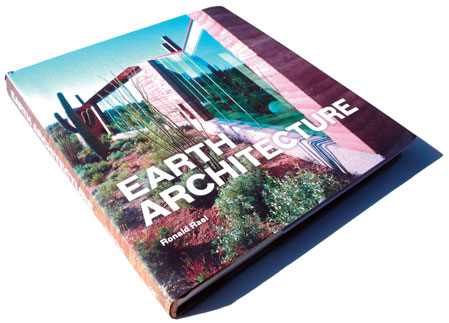
EARTH ARCHITECTURE — THE BOOK
Buy Earth Architecture if you live in the following countries::
[ U.S. | Japan
"Earth Architecture compellingly underscores the need for us to rethink how we can build sustainably by using old techniques in new ways."—Azure Magazine
written in "simple, descriptive prose, each project is traced in a way that creates an anthology and motivates the reader to further study and research. The book is rich in content and draws in other authors, architects, historical buildings and periods."—Building Design
"...a satisfying survey both for the professional "mudder" and for those who want a quick scholarly survey of earthen buildings from all over."—Architects Newspaper
A “Must Have”—WorldArchitectureNews.com
“...contains a wide range of modern earthen residences from the simple to the stunningly opulent. A beautiful book for earth-based building enthusiasts.”—GreenMuze.com
"...brings to the fore earth architecture and its positive impact on architectural design....an important addition to any architect's library for its important subject matter and the quality of projects included."—A Daily Dose of Architecture.com
Earth Architecture “charts a grand history of architectural beauty crafted from one of the humblest of building materials”.—The Age, Melbourne
Synopsis
Currently it is estimated that one half of the world's population—approximately three billion people on six continents—lives or works in buildings constructed of earth. And while the vast legacy of traditional and vernacular earthen construction has been widely discussed, little attention has been paid to the contemporary tradition of earth architecture. Author Ronald Rael, founder of Eartharchitecture.org provides a history of building with earth in the modern era, focusing particularly on projects constructed in the last few decades that use rammed earth, mud brick, compressed earth, cob, and several other interesting techniques. EARTH ARCHITECTURE presents a selection of more than 40 projects that exemplify new, creative uses of the oldest building material on the planet.
An engaging narrative addresses the misconceptions associated with earth architecture. Many assume that it's only used for housing in poor rural areas—but there are examples of airports, embassies, hospitals, museums, and factories that are made of earth. It's also assumed that earth is a fragile, ephemeral material, while in reality some of the oldest extant buildings on the planet are made of earth. The book also touches on many topics that pervade both architecture and popular media today, such as the ecological benefits and the politics of building with earth, particularly in developing nations where earth buildings are often thought of as pre-modern or backward. With captivating discussion and more than 300 images, Earth Architecture showcases the beauty and simplicity of one of humankind's most evolved and sophisticated building technologies.
ISBN 9781568987675 8.5 x 9 inches (21.6 x 22.9 cm), Hardcover, 208 pages 222 color illustrations; 96 b/w illustrations; A PAPress publication.
About the Author
Ronald Rael is an Architect, Author and Assistant Professor of Architecture at The University of California, Berkeley. He is the founder of EarthArchitecture.org, a clearing house of information on the subject.
EARTH ARCHITECTURE — THE WEBSITE
Dirt—as in clay, gravel, sand, silt, soil, loam, mud—is everywhere. The ground we walk on and grow crops in also just happens to be the most widely used building material on the planet. Civilizations throughout time have used it to create stable, warm, low-impact structures. The world's first skyscrapers were built of mud brick. Paul Revere, Chairman Mao, and Ronald Reagan all lived in earth houses at various points in their lives, and several of the buildings housing Donald Judd's priceless collection in Marfa, Texas, are made of mud brick. The Earth Architecture website focuses on architecture constructed of mud brick (adobe), rammed earth (pisé), cob, compressed earth block or other methods of earthen construction and serves as a database for the discussion and dissemination of events, resources, and images of earth architecture in the context of contemporary architecture culture.
No comments:
Post a Comment